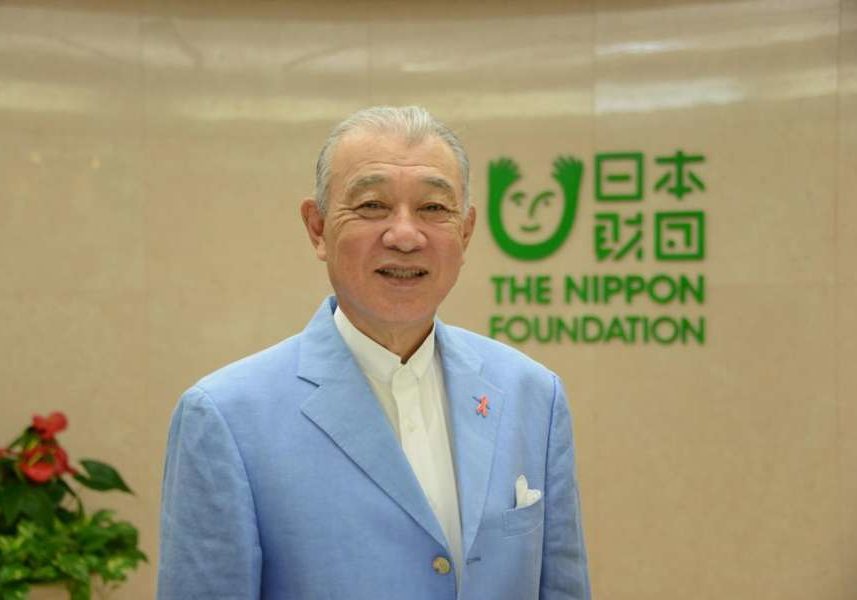Yohei Sasakawa, chairman of the Nippon Foundation, and the World Health Organization Goodwill Ambassador for Leprosy Elimination, was in India recently as part of the Sasakawa- India Leprosy Foundation’s (S-ILF) Anti Leprosy day event 2020.
Mr. Sasakawa spoke to News Ripples about the conditions of leprosy in India, its challenges and more.
What was the motivation for you to choose the fight against leprosy as your mission?
The first time I met people affected by leprosy was about forty years ago, when I visited a leprosarium with my father, Ryoichi Sasakawa. Those people were abandoned by their families, rejected by society all because they had leprosy.
I was shocked at the sight of the disfigured patients but my father took them by the hand, held them tight and cried. This was the first time I had ever seen him crying. And this is when I decided to devote my life to carrying on his work.
Since then, I have been committed to the struggle against leprosy and its associated stigma and discrimination around the world. My “battlefield” is where the problems lie as that is where solutions can be found.
S-ILF has signed the MoU with Confederation of Indian Industry (CII) to eradicate the social stigma faced by people affected by leprosy. How far has the private sector come in terms of creating opportunities for people affected by leprosy?
It is now a global trend of creating an inclusive society and an inclusive society means to provide equal opportunities to people with disabilities and to become a workforce. Several years ago, people with leprosy who had developed disabilities were not even seen as a part of the different disability groups, so finding jobs was a far cry.
However, with our various efforts to include those leprosy affected people who had developed disabilities into those groups, they have now instilled a passion and motivation to work. And this is where the MoU comes into play.
The MoU between S-ILF and CII will enable the members of CII to be educated on leprosy and with the correct understanding would open job opportunities for people with disabilities, including people affected by leprosy. The idea is for the CII to take leadership to further accelerate and promote the hiring of not only the leprosy-affected people but also leprosy affected disabled people going forward.
Where does India stand in terms of winning the battle against leprosy?
The work done in India towards leprosy is the most advanced as any other country in the world. To speak from the medical front, India has already achieved the elimination goal (1 per 10,000 population as set by WHO) back in 2005.
Since patients would not come to the hospitals to seek treatments, organizations like ASHA (Accredited Social Health Activist) are setup, to identify leprosy patients in every household. And such an initiative to identify new cases, does not exist in any other country than India. People are now approaching the “hotspots” areas, i.e the more remote areas which are difficult to access, to find more cases of leprosy. The rise in the number of new cases is, in fact, an achievement and not a sign of lack of government intervention.
Furthermore, we now also have a nationwide organization called APAL (Association of People Affected by Leprosy) which acts as a voice of 850 leprosy colonies in India. People living in these colonies do not always have access to electricity or water or sanitation, so my vision is not to have any elderly to beg to live. I’ve been in contact with state officials for special programs like to provide additional pensions to the elderly living in these colonies. This initiative has been done in Bihar, moving up to Delhi, Orissa, and Jharkhand.
The situation, therefore, from both the medical standpoint and social standpoint is showing advancement.
How does the stigma and discrimination towards leprosy and people affected by it hinder the fight against the disease?
Well, at this point there’s not much progress made on that front but PM Modi has made a commitment that by the year 2030, India would be free of leprosy and the stigma and discrimination towards it. So, I’m sure with the strong commitment, various approaches will be taken in order to tackle the issue.
When it comes to discrimination or stigma towards leprosy and people affected by leprosy in India, it is due to the misunderstanding of the disease which causes the stigmatization and the accompanying discrimination. There still exists misunderstandings such as leprosy is hereditary or it is a god’s curse, or even that it’s the karma that has come around to them- which are all false.
Furthermore, in the field of law, there are more than 100 (non-useable) but still officially existing discriminatory laws which restrict leprosy affected people to ride on trains, buses, and are even used as an excuse for divorce. Therefore, we need to eradicate the stigma at its root to solve the very issue of discrimination.
What is the significant factor in realising S-ILF’s mission?
People need to realise that leprosy is a condition which can be fully cured, seeking treatment at its early stages will prevent patients from developing any disabilities. Medical treatment is also easily available, free of cost and there should be no room for discrimination against people living with leprosy.

